Growing up left-handed is a tough gig. We left-handers can't write a sentence in ink without needing to wash our hands, classroom scissors malfunction in our claw-like grips, and driving a stick-shift requires a certain degree of ambidexterity. In little league, defensive assignments were restricted to roaming the outfield pasture unless one happened to have a hyperactive pituitary gland, thus earning a trip to play first base with the right-handed infielders. I was able to fool one coach into putting me at catcher for a season, but that experiment was predictably short-lived.
The mound is a southpaw's chance at redemption, where the bar for lefties to gain acceptance is lowered. Left-handers sit right in the cross-hairs of the supply-demand curve in the majors due to the limited player-pool as well as a league-wide desire to exploit platoon splits (see table for 2012 figures). Just 10 percent of the world is left-handed, yet southpaws have been on the mound for 31 percent of all plate appearances this season. Lefty batters make up 44 percent of plate appearances, a function of the advantages that are inherent in a two-step head-start down the line, combined with the reality that it is much easier to switch sides of the plate than it is to alternate throwing arms.
|
|
||||
|
RHP vs RHB |
.251 |
.309 |
.397 |
.707 |
|
RHP vs LHB |
.261 |
.333 |
.418 |
.751 |
|
LHP vs RHB |
.260 |
.326 |
.426 |
.752 |
|
LHP vs LHB |
.232 |
.296 |
.357 |
.653 |
The greatest platoon advantage across the board is for left-handed pitchers against like-sided batters, with a 99-point difference in OPS when compared to southpaw performance against right-handed hitters. The pressing need for left-handed pitchers has lowered the expectations for velocity and command in the professional ranks. This relative lack of stuff underlies the perceived need for coaches to tinker with left-handers' mechanics by toying with arm slots, positions on the rubber, and even stride direction.
The typical lefty has considerable funk in his delivery, with some sort of unorthodoxy that adds to the deception of his offerings, though most of the quirks are aimed specifically toward stopping left-handed hitters. The strategies tend to ignore the corollary that tough angles on left-handed batters tend to give right-handers a longer look at the ball, further exacerbating the platoon splits and limiting the LOOGY's functionality, leaving them extremely vulnerable to pinch-hitters from the right side.
The preferred method for left-handers is to release the ball from an extreme angle, a concept that has created a general approach dictating that a left-hander should pitch from the first-base side of the rubber. In the same vein, some coaches will advocate a strategy for directing a pitcher's stride at a closed angle, in which a southpaw appears to be charging toward the left-hand batter's box instead of guiding his momentum toward the plate. These pitchers will finish with the lead foot positioned to the arm-side of the centerline. The closed angle often requires a pitcher to over-rotate the shoulders in order to hit targets on the right-hand side of the plate, creating an obstacle to pitch execution. The technique is best employed with short relievers who face a greater proportion of like-sided hitters, as starting pitchers would be easily defeated by an opposing manager who stacked the lineup with right-handed bats.
Sidewinder pitchers, or those with a submarine delivery, tend to fall into the LOOGY camp due to the natural platoon splits that are generated from their flat trajectories, making them perfect candidates for further angular exploitation via a closed stride. The platoon phenomenon provides the functional basis for closed-stride LOOGYs, though it is a questionable strategy to mold these left-handed pitchers in a way that disrupts the other mechanical elements in the effort to achieve an advantage versus a single batter. It is rare to spot a right-handed pitcher who exaggerates a closed stride, but a general acceptance of the philosophy for southpaws has created a tendency for some starting pitchers to adopt the technique, despite the fact that starters are expected to face opposing lineups that are stacked with platoon bats.
One such example is Tyler Skaggs of the Diamondbacks' system, who was profiled in the review of the US team for the Futures Game, while the World team offered up their own example in lefty Chris Reed. I described Skaggs as having an S-shape to his momentum, due to a tendency to stride far to the left prior to redirecting his energy back toward the target, while Reed displayed a muted version of Skaggs' zig-zag pattern. The alternative is for a lefty to stride straight at the plate, as demonstrated below by Atlanta Brave Jonny Venters, where the front foot is positioned along a straight line from the back foot to the plate.
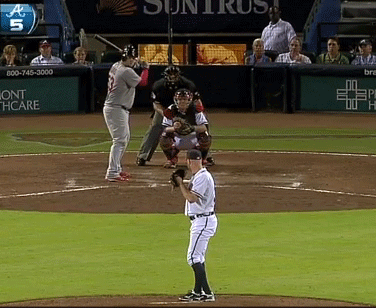
Most of the closed-stride pitchers find themselves in the LOOGY role due to extreme platoon splits, resulting in their facing very few batters per game. The Yankees have two lefties who fit the LOOGY description.
|
|
IP / Game |
PA vs LHB |
2012 Split |
Career Split |
|
0.72 |
57.7% |
-48 |
-162 |
|
|
0.59 |
73.9% |
-98 |
-539 |
Logan's short stints and high rate of opposing lefties solidifies his LOOGY status, though his platoon splits this season are off of his career rates of like-sided dominance. Logan uses a closed stride that is angled to the left of the centerline, though his example is not as blatant as some of the other pitchers in his cohort. He appears to direct his energy directly at any hitter who stands in the left-hand batter's box, which is as intimidating as it is deceptive. The complicated approach causes Logan to struggle to find a release point that allows his shoulders to square to the target, with an interesting mix of deception and wildness that contribute to high walk rates mixed with a killer K rate. In the video below, Logan releases the ball early in the kinetic sequence such that the pitch misses inside of its intended location, though the batter was still fooled by the action on the pitch.
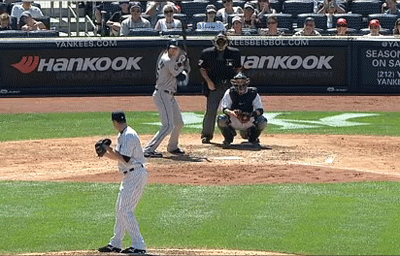
Logan's teammate, Clay Rapada, is a more extreme LOOGY example with an astounding usage pattern that sees nearly three-quarters of his opponents hail from the left side. Rapada is used in very short stints that average just over half an inning per game played, and though his platoon splits are roughly average in 2012, he is well off the torrid pace that he had set during the past few years spent bouncing around the American League, in which left-handed batters had been limited to a sub-.500 OPS while right-handers raked to the tune of a 1.000-plus mark. A low hit rate helps to mask a career walk rate of more than five walks per nine innings, further solidifying the trade-off of command and deception that is typical of such closed-striding LOOGYs. Rapada's stride is aimed at a spot almost behind the batter, with a sidearm delivery that adds more to the angular deception of his pitches. Notice how late he has to release the pitch in order to hit a location on the right-side edge of the plate.
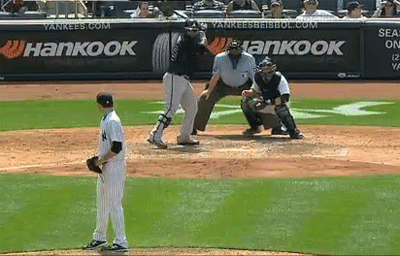
Like the Yankees, the Phillies have a pair of lefties that use the closed-stride technique to create angles at release point, though manager Charlie Manuel has utilized a different pattern with the strategic deployment of his southpaw charges.
|
|
IP / Game |
PA vs LHB |
2012 Split |
Career Split |
|
0.81 |
41.3% |
-148 |
-6 |
|
|
0.93 |
44.5% |
-104 |
-104 |
Bastardo owns a career platoon split that is nearly neutral, a fact that helps to explain his scant 41-percent usage pattern against lefty batters. He carries a hefty split this season, with Bastardo being used for shorter stints early in the year against a higher percentage of opposing lefties, but Manuel has stretched the southpaw out as the season has progressed. Bastardo uses a closed stride, but he had a reverse platoon split last season, yielding a 52-point higher OPS to lefties, and his neutral splits over a four-year career are all the more curious given his lack of an off-speed pitch.
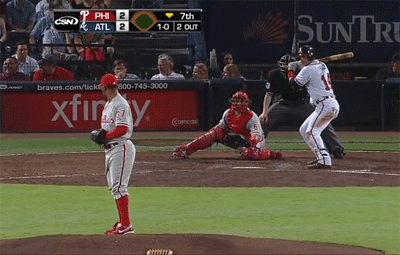
Fellow Phillie southpaw Jake Diekman is another closed-stride reliever, though the rookie's platoon splits are more typical of major-league left-handers. Diekman falls short of pure LOOGY status, with a tendency toward longer outings in addition to a relatively low percentage of opposing lefties faced this season. Sample-size caveats abound for a pitcher with just 21 innings under his belt, where a couple of batters could skew his numbers significantly, and one might expect that a player with such an extreme stride angle would carry a much heavier split in the future.
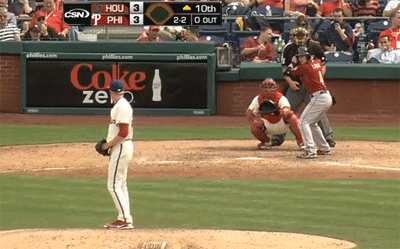
Across the country to the west, the Giants and Padres have two of the most extreme LOOGYs of 2012.
|
|
IP / Game |
PA vs LHB |
2012 Split |
Career Split |
|
0.49 |
61.8% |
-400 |
-189 |
|
|
0.66 |
45.2% |
-358 |
-87 |
Lopez's usage pattern is selective, with more than 60 percent of his plate appearances falling within the confines of the platoon advantage, to which he has responded by allowing an OPS that is an absurd 400 points lower when facing like-sided hitters. Manager Bruce Bochy is a big fan of the LOOGY strategy and limits the workload to under a half-inning per game for Lopez, a wise decision given the sidearm southpaw's 1.71 WHIP on the season and the 1.024 OPS he has yielded to right-handed batters.
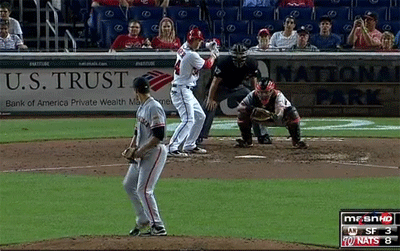
San Diego's Joe Thatcher has platoon splits that are nearly as egregious as those of Lopez, despite a career mark that is close to league average. Overall, the Padre has faced a much lower percentage of lefties than Lopez, though it is interesting to note that his percentage is a near match for Lopez’ when considering only the first batters that he faces upon entering the game. The comps don't end there, with Thatcher employing a sidearm delivery that comes from a vicious angle thanks to an extremely closed stride that draws a striking similarity to the delivery of Lopez. Thatcher also employs the distinct S-shape pattern of Tyler Skaggs, thrusting his momentum in one direction before the rotational elements of the delivery propel him to change course.
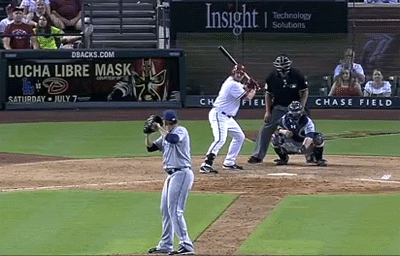
Not all closed-striding southpaws demonstrate a predictable performance pattern, with a couple of oddballs scattered throughout the league who defy conventional wisdom.
|
|
IP / Game |
PA vs LHB |
2012 Split |
Career Split |
|
0.84 |
40.1% |
-289 |
-119 |
|
|
0.75 |
60.3% |
+149 |
-71 |
Sean Burnett is a curious case of a pitcher with an extreme platoon split yet a remarkably low rate of batters faced from the left side. Interestingly, just 11 of his first 29 games began with his facing a right-handed hitter, yet he has seen opposite-handed opponents on the first pitch of 15 of his last 21 appearances. Burnett has perhaps the most extreme stride of all of the pitchers covered, with momentum that looks as if it is being directed toward the Blue Jay logo that sits far outside the left-hand batter's box.
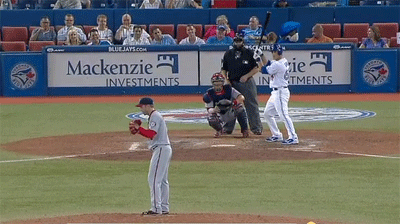
Scott Elbert might just be the most intriguing case of all the southpaws under the microscope, as he has posted a massive reverse-platoon split this season despite owning a closed stride that rivals most of the other hurlers on this list. His career platoon split is more in line with expectations, yet it still falls short of the like-sided dominance that one would expect from a LOOGY who faces lefties more than 60 percent of the time. Elbert's platoon split was at -.209 last season, but his crossover to the land of reverse splits may have altered the way that opposing managers have approached him this year. Consider the case of the May 2nd game in Colorado that Elbert entered to face the switch-hitting Dexter Fowler, only to have Rockies manager Jim Tracy pinch-hit with 60-year old left-hander Jason Giambi. The choice to defy platoons worked out, as Giambi sent Elbert's second pitch high into the right-field stands for a walk-off homer that stands as Giambi's only round-tripper of the season. The homer sent shockwaves through the stadium that were strong enough to propel one front-row fan to literally fly out of his seat.
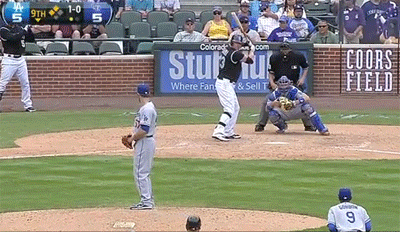
|
|
IP / Game |
PA vs LHB |
2012 Split |
Career Split |
|
1.30 |
42.9% |
-349 |
-349 |
|
|
1.11 |
50.0% |
-971 |
-659 |
Finally, we wrap up the review of closed-stride southpaws with a pair of pitchers whose numbers carry the heavy accent of small sample size, with Loup and Hottovy having pitched fewer than 25 innings in their combined careers. Despite the lack of reliability offered by so few innings at the major-league level and a current tendency toward longer outings, their manipulated strides pave the way for the two sidewinders to achieve LOOGY status in the future, if they can find the consistency necessary to stick in the bigs.
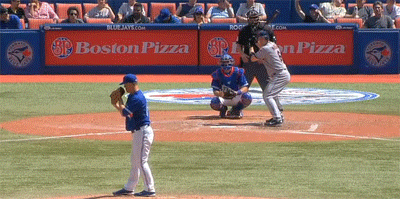
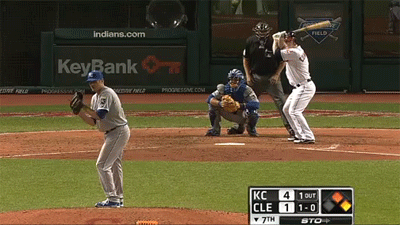
Thank you for reading
This is a free article. If you enjoyed it, consider subscribing to Baseball Prospectus. Subscriptions support ongoing public baseball research and analysis in an increasingly proprietary environment.
Subscribe now
One note: while Elbert's windup is of the traditional LOOGY variety (i.e. he hides the ball, has a big leg kick, etc.), notice that his arm comes in pretty much over the top, which would explain why his numbers vs. lefties and righties is pretty much insignificant (lefties have a .310 wOBA and righties have a .314 wOBA for his career). If he was ever to drop down and become more of a sidearmer against lefties, I'd bet we'd see better results vs. them, but it would be off-set in a zero sum sense because he'd lose effectiveness versus righties. If he could ever drop down against lefties and keep his regular arm angle against righties, it'd be a fun thing to watch.